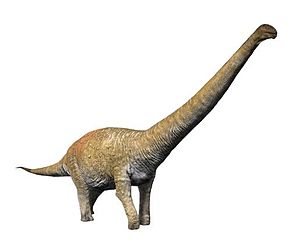Notocolossus
| Notocolossus | ||||||||||||
|---|---|---|---|---|---|---|---|---|---|---|---|---|

Live reconstruction |
||||||||||||
| Temporal occurrence | ||||||||||||
| Coniacium to Santonium | ||||||||||||
| 89.7 to 83.6 million years | ||||||||||||
| Locations | ||||||||||||
|
Argentina, Mendoza Province |
||||||||||||
| Systematics | ||||||||||||
|
||||||||||||
| Scientific name | ||||||||||||
| Notocolossus | ||||||||||||
| González Riga , Lamanna , Ortiz David , Calvo & Coria , 2016 | ||||||||||||
Notocolossus with the only species Notocolossus gonzalezparejasi was a herbivorous sauropod from the family of the titanosaurs or the Lithostrotia and lived during the Upper Cretaceous . The site is near Malargüe in the south of the province of Mendoza in what is now Argentina .
formation
The find layer is the Plottier Formation from the time of transition from Coniacium to Santonium 86 million years ago. From this, in addition to this species, the sauropods Antarctosaurus , Muyelensaurus and Petrobrasaurus have been found.
Initial description
In 2016, the UNCUYO-LD 301 holotype was first described as Notocolossus gonzalezparejasi by paleontologists Bernardo Javier Gonzalez Riga , Matthew Carl Lamanna , Leonardo Daniel Ortiz David , Jorge Orlando Calvo, and Juan Pedro Coria . The generic name combines the ancient Greek words νότος Notos , "south wind" and κολοσσός, Colossus "huge statue", in reference to the southern origin and the enormous size of the animal. The name specification honors the paleontologist Jorge Gonzalez Parejas .
Finds
The discovered animal consists of a partial skeleton without the (relatively) small skull. What is preserved is an anterior vertebra (probably the second or third thoracic vertebra ), an anterior caudal vertebra, a 1.76 meter long humerus and the tip of a left pubic bone. The bones were not in anatomical relation, but together on an area of about 8 by 8 meters. therefore they were assigned to a single animal.
A second partial skeleton (UNCUYO-LD 302), also without a skull, was found at the same site and was assigned to a somewhat smaller animal. It consists of a contiguous portion of the tail spine with seven vertebrae and a right hind leg with the ankle bone (talus), the bones of the foot with the foot to the shin and calf bone articulated. The species had four toes with two toe bones (phalanges) each . A relatively short, very robust and symmetrical foot is reconstructed.
description
Notocolossus was a huge sauropod with an estimated length of about twenty-five meters. The weight estimates using the method of Nicolás E. Campione and David C. Evans come to a weight of approximately 40 tons. Araucarias which the animal swallowed whole and then digested for a long time served as food .
Even bigger kind
On May 16, 2014, the discovery of seven partial skeletons of a previously unnamed titanosaur species that were larger than Notocolossus and Puertasaurus was announced. They come from near La Flecha , about 250 km west of Trelew in the province of Chubut . The excavation was carried out under the paleontologists Jose Luis Carballido and Diego Pol of the Museum of Paleontology Egidio Feruglio . The "new dinosaur" is likely to be the largest land creature known to date. The author and wildlife filmmaker David Attenborough documented the excavation and the reconstruction based on the original finds. After the discovery, author Brian Switek pointed out that it was too early to calculate the exact size of these dinosaurs.
literature
- J. Bernardo Gonzalez Riga, Matthew C. Lamanna, Leonardo D. David Ortiz, Jorge Calvo and Juan P. Coria: A gigantic new dinosaur from Argentina and the evolution of the sauropod hind foot . In: Scientific Reports 6 , article number: 19 165 doi: 10.1038 / srep19165

